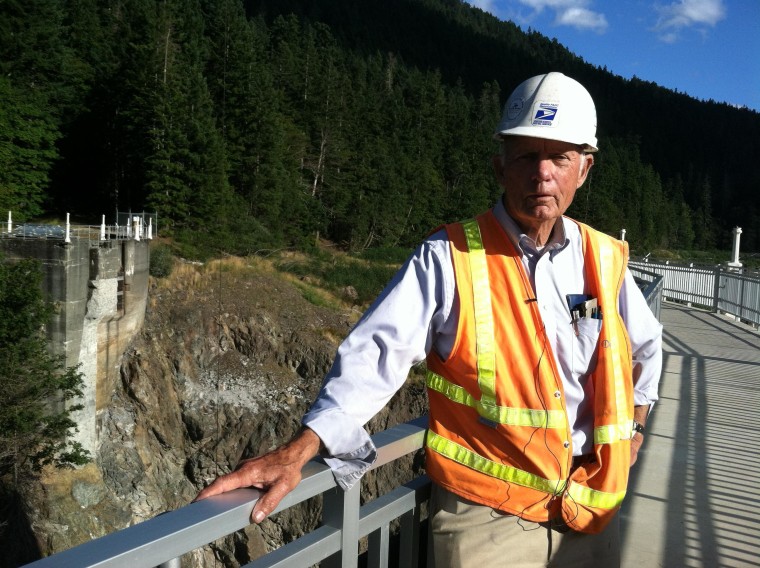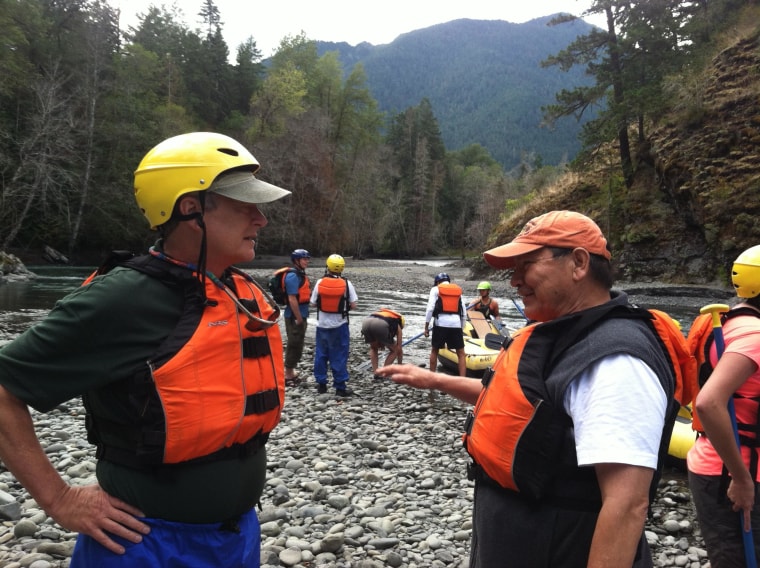In Olympic National Park, the past has gone out with a bang.
A small construction crew on Tuesday detonated a large charge of dynamite, destroying the last remaining portion of Glines Canyon Dam and hastening the restoration of the Elwha River in the far reaches of the Pacific Northwest. Part of the largest dam-removal project in the nation, the $325 million undertaking represents the beginning of a new era for the river, the surrounding ecosystem and those who come to experience it.
“It’s taken 25 to 30 years to get to this point,” said park spokesperson Barb Maynes, “so it’s great to see it actually happen.”
Located just west of Port Angeles, Washington, the Elwha drains the largest watershed on the Olympic Peninsula and once supported legendary salmon runs including king salmon, also known as chinook, that reputedly tipped the scales at 100 pounds.
Then local entrepreneur Thomas Aldwell built a pair of dams on the river, starting with the 108-foot-high Elwha Dam, completed in 1913, and then the 210-foot-high Glines Canyon Dam, completed in 1927. Neither featured fish ladders, effectively reducing 70 miles of salmon spawning habitat to just five.
“It’s going to take another 30 to 100 years to see complete restoration. Taking the dams out is just the beginning of the story.”
Other problems arose over time, from sediment build-up behind the dams to coastal erosion to the incompatibility of having the Glines Canyon dam and a man-made reservoir in what became a national park in 1938. It all came to a head in the 1980s with legal challenges, political battles and eventually the passage of the Elwha River Ecosystem and Fisheries Restoration Act in 1992.
The Elwha Dam, just outside the park, was removed in 2012, and all but 35 feet of the Glines Canyon Dam is gone. The silt-laden reservoirs that once lay behind them have begun to flow freely through forests in various states of recovery.

“It’s going to take another 30 to 100 years to see complete restoration,” said Rob Smith, Northwest regional director for the National Parks Conservation Association. “Taking the dams out is just the beginning of the story.”
Even so, dramatic changes are already on display, says Morgan Colonel, owner of Olympic Raft and Kayak, which runs float trips on the eight-mile stretch between the two dam sites. “The dam removal is why I moved here,” he said. “It’s the chance to experience a whole new river.”
Manning the oars on a recent afternoon, he provided a running commentary on the evolving landscape. New banks sport red alder and cottonwood saplings. Log jams are catching sediment and creating new islands. River channels change with every rainstorm, and sandy beaches are replacing beds of cobble and rock.
And, perhaps most important of all, the return of that icon of the Pacific Northwest: the salmon, which are not only returning in larger numbers but also swimming farther upstream. “Last year, we saw king salmon above the Elwha Dam site,” said Smith. “To see fish swimming where no one has seen them for 100 years is amazing.”
That, in turn, has led to a concurrent rebound in other wildlife, including otters, ospreys and bald eagles. Surf smelt and Dungeness crab are also beginning to return to local waters as sediment-rich beaches and sandy bottoms replace the rocky shores near the mouth of the river, said Robert Elofson, river restoration director for the adjacent Lower Elwha Klallam tribe.

Recreational options are increasing as well. Last week, the National Park Service began offering free guided hikes along the river where the reservoir behind Elwha Dam used to be, and viewing platforms at the Glines Canyon site could open by the end of the year. Depending on water flows, sediment transport and continued debris removal, Colonel hopes to eventually offer trips through the Elwha Dam site, where Class IV rapids will turn today’s float trips into white-knuckle whitewater adventures.
For his part, Elofson is taking a somewhat longer view: “My grandfather was 19 or 20 when the first dam was built; he was one of the last ones to fish the river as it was. I have grand hopes that when my grandkids are adults, they’ll be able to fish the same river.”
